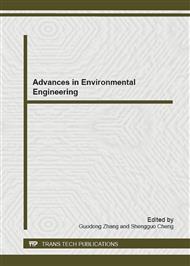[1]
P.A. Arkin, P.E. Ardanuy, Estimating climatic-scale precipitation from space, Journal of Climate 2 (1989), 1229-1238.
DOI: 10.1175/1520-0442(1989)002<1229:ecspfs>2.0.co;2
Google Scholar
[2]
R.R. Ferraro, F. Weng, N.C. Grody and A. Basist, An eight-year (1987-1994) time series of rainfall, clouds, water vapor, snow cover, and sea ice derived from SSM/I measurements, Bulletin of the American Meteorological Society 77 (1996), 891-905.
DOI: 10.1175/1520-0477(1996)077<0891:aeytso>2.0.co;2
Google Scholar
[3]
G.W. Petty, W.F. Krajewski, Satellite estimation of precipitation over land, Hydrological Sciences Journal 41 (1996), 433-451.
DOI: 10.1080/02626669609491519
Google Scholar
[4]
R.O. Duda, P.E. Hart, D.G. Stork, Pattern Classification, second ed., A Wiley-interscience Publication, John Wiley & Sons, 2000.
Google Scholar
[5]
D.M. Mount, N.S. Netanyahu, R. Silverman, A.Y. Wu, Chromatic nearest neighbor searching: A query sensitive approach, Computational Geometry 17 (2000), 97-119.
DOI: 10.1016/s0925-7721(00)00021-3
Google Scholar
[6]
P. Viswanath, M.N. Murty, S. Bhatnagar, Fusion of multiple approximate nearest neighbor classifiers for fast and efficient classification, Information Fusion 5 (2004), 239-250.
DOI: 10.1016/j.inffus.2004.02.003
Google Scholar
[7]
Y.S. Chen, Y.P. Hung, T.F. Yen, C.S. Fuh, Fast and versatile algorithm for nearest neighbor search based on a lower bound tree, Pattern Recognition 40 (2007), 360-375.
DOI: 10.1016/j.patcog.2005.08.016
Google Scholar
[8]
A.O. Finley, R.E. McRoberts, Efficient k-nearest neighbor searches for multi-source forest attribute mapping, Remote Sensing of Environment 112 (2008), 2203-2211.
DOI: 10.1016/j.rse.2007.08.024
Google Scholar
[9]
Y.C. Liaw, C.M. Wu, M.L. Leou, Fast k-nearest neighbors search using modified principal axis search tree, Digital Signal Processing 20 (2010), 1494-1501.
DOI: 10.1016/j.dsp.2010.01.009
Google Scholar
[10]
C.C. Wei, N.S. Hsu, Optimal tree-based release rules for real-time flood control operations on a multipurpose multireservoir system, Journal of Hydrology 365 (2009), 213-224.
DOI: 10.1016/j.jhydrol.2008.11.038
Google Scholar
[11]
C.C. Wei, Wavelet kernel support vector machines forecasting techniques: Case study on water-level predictions during typhoons, Expert Systems with Applications 39 (2012), 5189-5199.
DOI: 10.1016/j.eswa.2011.11.020
Google Scholar
[12]
Wikipedia, http://en.wikipedia.org/wiki/Machine_learning/, 2012.
Google Scholar
[13]
R. Weber, H.J. Schek, S. Blott, A Quantitative Analysis and Performance Study for Similarity Search Methods in High Dimensional Spaces. Very Large Databases (VLDB), New York, 1998.
Google Scholar
[14]
A.N. Papadopoulos, Y. Manolopoulos, Nearest Neighbor Search: A Database Perspective. Springer, 2005.
Google Scholar
[15]
T.A. Lasko, J.G. Bhagwat, K.H. Zou, L. Ohno-Machado, The use of receiver operating characteristic curves in biomedical informatics, Journal of Biomedical Informatics 38 (2005), 404-415.
DOI: 10.1016/j.jbi.2005.02.008
Google Scholar
[16]
G. Vanagas, Receiver operating characteristic curves and comparison of cardiac surgery risk stratification systems, Interactive CardioVasc Thoracic Surgery 3 (2004), 319-322.
DOI: 10.1016/j.icvts.2004.01.008
Google Scholar
[17]
J.A. Swets, Signal detection theory and ROC analysis in psychology and diagnostics: Collected papers. Lawrence Erlbaum Associates, Mahwah, NJ, 1996.
DOI: 10.1177/0272989x9901900216
Google Scholar
[18]
M. Greiner, D. Pfeiffer, R.D. Smith, Principles and practical application of the receiver-operating characteristic analysis for diagnostic tests, Preventive Veterinary Medicine 45 (2000), 23-41.
DOI: 10.1016/s0167-5877(00)00115-x
Google Scholar
[19]
J.A. Swets, Measuring the accuracy of diagnostic systems, Science 240 (1988), 1285-1293.
DOI: 10.1126/science.3287615
Google Scholar


